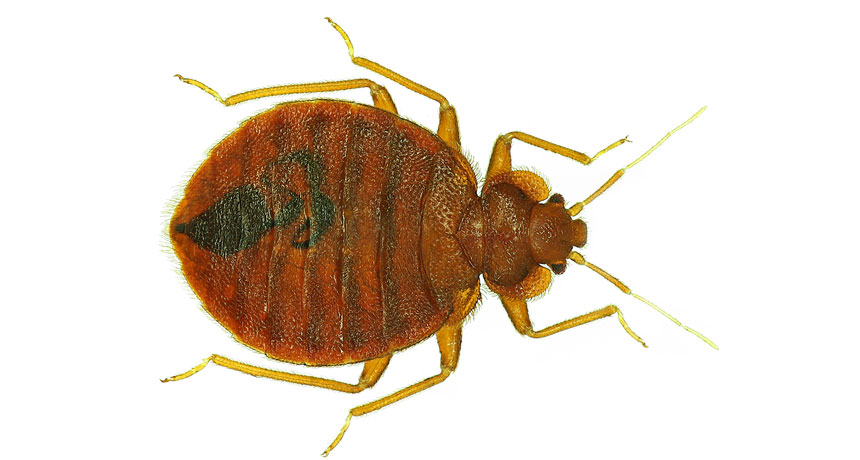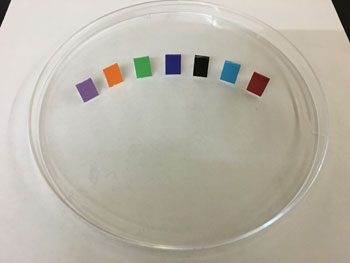Bed bugs have favorite colors
When these blood-suckers reach adulthood, they prefer red and black

A bed bug’s favorite colors change with age. By the time they are adults, they like red and black.
marcouliana / iStockphoto
Do you have favorite colors? So does a bed bug. And a new study shows that, like many humans, bed bugs change their color preferences as they age.
“It’s just like when you were four, you might have liked the color blue. But when you get to eight, you might say, ‘I don’t like blue anymore. I like green.’ Then at 12, you say, ‘I really like black,'” explains Corraine McNeill. She is one of the study’s authors and an entomologist. That is a scientist who studies insects. She works at Union College in Lincoln, Neb. Her team’s study was published April 25 in the Journal of Medical Entomology.
Bed bugs are tiny, blood-sucking insects that can infest people’s homes. They may live in beds or other soft furniture. And they are tough to get rid of. Previous research showed these bugs like the colors red and black and don’t like white, yellow or green. That’s probably a survival strategy, says McNeill. It’s harder for predators, including humans, to see the reddish-brown bugs on a dark background.
But earlier studies had looked only at adult bugs. McNeill and her team tested the color preferences of bed bugs throughout their lives. Baby bugs, or nymphs, pass through five molts before becoming adults. (A molt is when a young bug sheds its skin.) The researchers found that as bed bugs move through these life stages, their favorite colors change.
To find out what color bed bugs like at each stage of life, McNeill started with tiny pieces of colored cards. She folded each into a tent 1 centimeter by 2 centimeters (0.4 inch by 0.8 inch). That was big enough for a bug to take shelter in. Each tent was a different color: lilac, violet, blue, green, orange, red or black. Since earlier tests showed bed bugs avoided yellow and white, the researchers skipped these colors.
McNeill placed the paper tents in a large Petri dish. In the middle of the dish she placed a single bed bug. The bugs, which don’t like to be exposed, ran for one of the tents. McNeill repeated this during each stage of a bed bug’s life.
At each age, the bed bugs tended to run to tents of different colors. Sometimes, the color they liked at one stage became a color they avoided at another.

McNeill thinks these changes in color preference have to do with the way the bugs’ eyes develop. Their eyes are made up of tiny bumplike structures called ommatidia. These are the individual light-sensing and focusing elements of their compound eyes. “As [the bugs] get older, the number and size of bumps increases,” says McNeill. “We think maybe that’s why their color preference changes.”
It takes bed bugs only about five weeks to become adults. They can live for four months to a year. So the colors that they prefer as adults may be most important for people trying to control the bugs. But this doesn’t necessarily mean people should throw out black and red bedding, says McNeill. Tiny paper tents, after all, are not the same as entire beds.
“We would need to put white sheets on one bed and red or black sheets on another and see which they prefer,” she says. “Nobody has done that research.”
Changlu Wang did some of the earlier research showing adult bed bugs prefer red and black. Also an entomologist, he works at Rutgers University in New Brunswick, N.J. Wang agrees that getting rid of red or black bedding wouldn’t necessarily help people fight bed bugs. But frequently washing sheets and blankets in hot water can help. So can calling in pest control experts to spray pesticides.
Paying for a pest control expert can be hard for people who don’t have a lot of money, though. So infestations in low-income neighborhoods can be tough to fight.
Wang and his team looked for bed bugs in 2,372 low-income apartments. These were in 43 buildings in four New Jersey cities. On average, slightly more than 12 percent of apartments had bed bugs, they found. This is higher than when bed bugs were common in the 1940s, in England, Wang notes. Back then, he says, “the infestation rate was usually much less than 10 percent.” (There is no research to show how common bed bugs are in middle-income apartments, notes Wang.)
His group’s study was published April 5 in the Journal of Medical Entomology.
While bed bugs aren’t known to transmit diseases to humans, they are still a problem. The most frequent symptoms reported by people in Wang’s study were pain, itchiness, welts and trouble sleeping. But bed bug bites don’t affect everyone in the same way. That may be why 49 percent of the infestations he and his team found were in apartments whose residents didn’t know they had bed bugs.
“That’s the amazing part of doing this kind of survey,” says Wang. “Some people don’t react, even with a lot of bed bugs.”
Power Words
(for more about Power Words, click here)
bed bug A parasitic insect that feeds exclusively on blood. The common bed bug, Cimex lectularius, sucks human blood and is mainly active at night. The insect’s bite can cause skin rashes and welts that sometimes look like a mosquito bite, but different people react in different ways.
compound eye The type of eye in arthropods, such as insects, spiders and lobsters. It consists of many identical light-sensing and focusing elements, called ommatidia. They all sit, squished side-by-side, across the surface of each eye collecting light and working together to provide the animal’s vision.
entomology The scientific study of insects. One who does this is an entomologist. A paleoentomologist studies ancient insects, mainly through their fossils.
infest To create a parasitic community, such as when wasps infest the porch of an abandoned house. Such a community of pests is known as an infestation.
insect A type of arthropod that as an adult will have six segmented legs and three body parts: a head, thorax and abdomen. There are hundreds of thousands of insects, which include bees, beetles, flies and moths.
molt (v.) To cast or shed skin, exoskeleton or feathers, which will be replaced with new. (n.) The act of molting, or the thing that is dropped during molting.
nymph A stage in the life cycle of some insects in which the immature individual resembles the adult. As nymphs grow, they will molt, or shed their external “skeleton,” several times. Unlike butterflies, which have a dormant stage of life called a pupa before becoming adults, nymphs remain active and will directly enter adulthood after their final molt.
ommatidia (sing. ommatidium) The individual units making up the surface of an insect’s compound eye. Each works as a separate visual receptor. A single eye may consist of more than 1,000 of these hexagonal (six-sided) units. Each ommatidium contains its own lens and set of light sensing vision cells.
pesticide A chemical or mix of compounds used to kill insects, rodents or other organisms harmful to cultivated plants, pet or livestock, or unwanted organisms that infest homes, offices, farm buildings and other protected structures.
Petri dish A shallow, circular dish used to grow bacteria or other microorganisms.
predator (adjective: predatory) A creature that preys on other animals for most or all of its food.
welt (in medicine) A raised and usually swollen patch of skin. It often appears reddened and can result from a bump, pressure or an insect bite.







